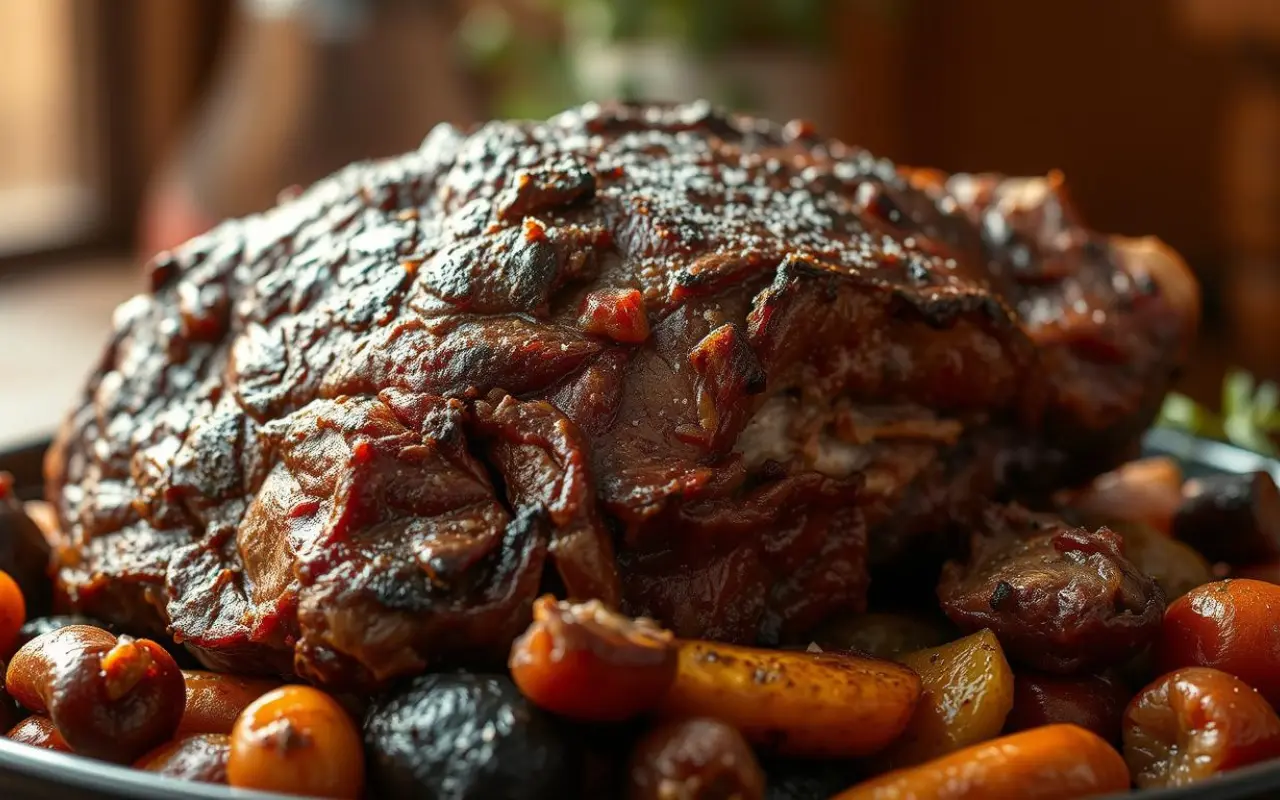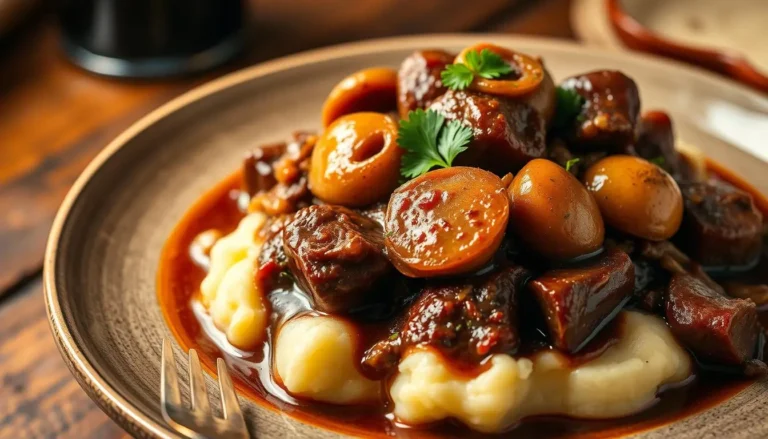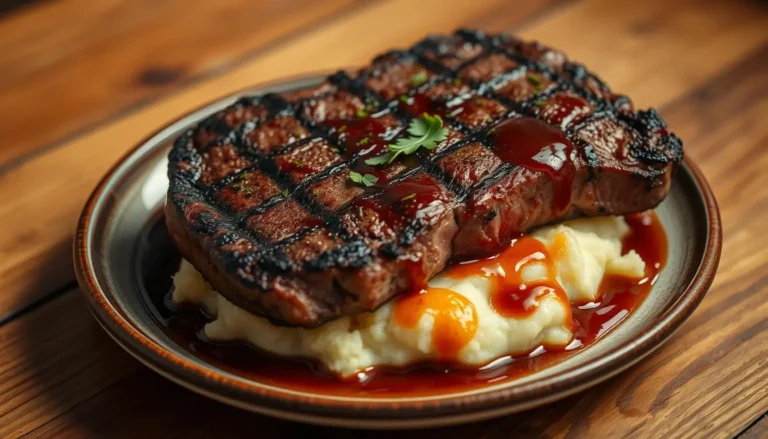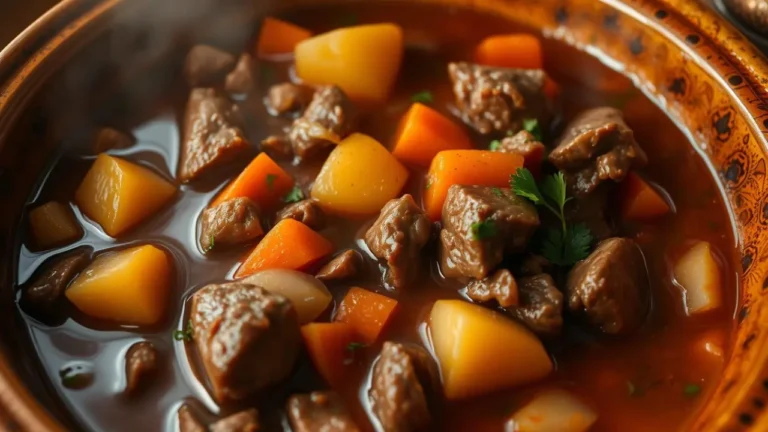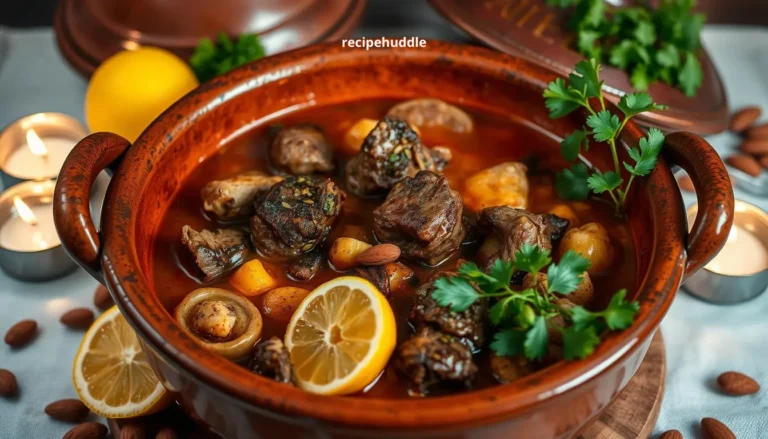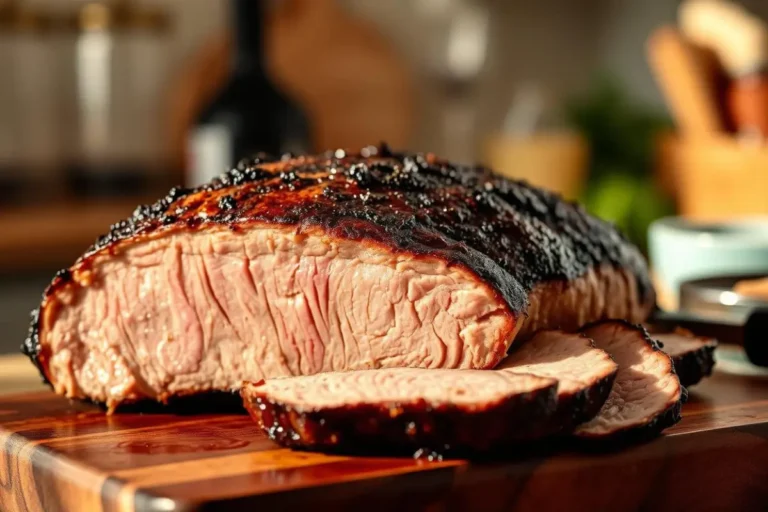Slow-Cooked Beef Roast: Mouthwatering Dish
Imagine coming home to the savory aroma of a tender, fall-apart beef dish that’s been cooking all day, The appeal of a slow-cooked meal lies in its simplicity and the rich flavors it develops over time.
Cooking tougher cuts of meat over low heat for an extended period results in a melt-in-your-mouth texture that’s hard to resist. This method is not only delicious but also convenient, allowing for hands-off cooking that’s perfect for busy days.
Key Takeaways
- A slow-cooked beef roast is a tender and flavorful dish perfect for any occasion.
- Cooking low and slow develops rich flavors and tender texture.
- This method is convenient and allows for hands-off cooking.
- Tougher cuts of beef become tender and palatable.
- The result is a mouthwatering dish that’s sure to impress.
The Art of Slow Cooking Beef
Slow cooking beef is an art that transforms tougher cuts into tender, flavorful masterpieces, This culinary technique involves cooking the beef at a low temperature for an extended period, resulting in a dish that’s both delicious and satisfying.
The slow cooking process is particularly effective for tougher cuts of beef, as it breaks down the connective tissues, making the meat tender and easily shredded, As Chef Jacques Pépin once said,
“The secret to a good beef stew or pot roast is in the slow cooking, It’s not just about throwing ingredients together; it’s about coaxing out the flavors”
Why Slow Cooking Creates Tender Results
Slow cooking creates tender results by breaking down the collagen in the meat into gelatin, This process occurs when the meat is cooked at a low temperature for a long duration, typically several hours, The result is a tender beef roast that’s full of flavor.
The Science Behind Breaking Down Tough Cuts
The science behind slow cooking lies in its ability to break down the tough connective tissues in the meat, When you cook tougher cuts of beef slowly, the collagen breaks down, resulting in a tender and juicy final product.
This process is explained in detail in Exploratorium’s Science of Meat, which highlights how moist heat and time convert collagen into gelatin, enhancing both texture and flavor.
To achieve the best results, it’s essential to understand the type of beef you’re working with and adjust your cooking technique accordingly, By doing so, you’ll be able to create a tender beef roast that’s sure to impress.
Choosing the Perfect Cut for Your Slow-Cooked Beef Roast Recipe
When it comes to slow-cooked beef roast, the cut of beef you choose can make all the difference, The right cut can result in a tender, flavorful dish that’s sure to impress.
Best Beef Cuts for Slow Cooking
Certain cuts of beef are better suited for slow cooking than others, These cuts are typically tougher and benefit from the low and slow cooking process.
- Chuck Roast: Known for its rich flavor and tender texture when cooked low and slow.
- Brisket: A flavorful cut that becomes tender with slow cooking, often used in barbecue.
- Round Roast: Leaner than chuck roast, it still offers great flavor and texture when slow-cooked.
Chuck Roast
Chuck roast is a popular choice for slow-cooked beef roast due to its marbling, which adds flavor and tenderness.
Brisket
Brisket is another excellent option, offering a rich, beefy flavor that’s enhanced by slow cooking.
Round Roast
Round roast is a leaner cut that still benefits from slow cooking, resulting in a tender and flavorful roast.
Understanding Marbling and Its Importance
Marbling refers to the intramuscular fat that’s dispersed throughout the meat, This fat melts during cooking, making the beef more tender and flavorful.
Why Marbling Matters:
- Enhances flavor
- Increases tenderness
- Contributes to a more enjoyable texture
Budget-Friendly Options That Still Deliver
You don’t have to break the bank to enjoy a delicious slow-cooked beef roast, Several budget-friendly cuts can still yield great results.
- Look for cuts with good marbling for better flavor and tenderness.
- Consider purchasing larger cuts and portioning them out for future meals.
- Shop during sales or use coupons to reduce the cost.
Essential Equipment for Perfect Slow-Cooked Roasts
When it comes to achieving the perfect slow-cooked roast, having the right equipment is crucial, The choice of cooking vessel can significantly impact the tenderness and flavor of your roast.
Slow Cooker vs. Dutch Oven Comparison
Two popular options for cooking a savory pot roast are slow cookers and Dutch ovens, Both have their advantages and are suited for different cooking needs.
Temperature Control Benefits
Slow cookers offer precise temperature control, allowing for a consistent cooking temperature, This is particularly beneficial for cooking tougher cuts of meat, as it ensures they become tender without overcooking.
Size and Capacity Considerations
Dutch ovens, on the other hand, offer versatility in cooking techniques, They can be used for browning meat on the stovetop before slow cooking, enhancing the flavor of your easy slow-cooker roast, When choosing between the two, consider the size and capacity that best suits your needs.
Here are some key considerations:
- Slow cookers are ideal for hands-off cooking and can be left unattended for long periods.
- Dutch ovens provide the flexibility to cook on the stovetop, in the oven, or even over a campfire.
Additional Tools That Enhance Results
Beyond the cooking vessel, there are several tools that can enhance the outcome of your slow-cooked roast.
Meat Thermometers
A meat thermometer is essential for ensuring your roast is cooked to the perfect doneness, It eliminates guesswork and helps prevent overcooking.
Kitchen Twine and Butcher’s Knots
Using kitchen twine to tie your roast (a technique known as butcher’s knots) can help it cook more evenly, This simple step can make a significant difference in the final presentation and texture of your roast.
Some additional benefits of using these tools include:
- Improved tenderness and flavor distribution.
- Easier handling and serving of the roast.
- Enhanced presentation, making it suitable for special occasions.
Preparing Your Beef for Slow Cooking
Before you start slow cooking your beef, it’s essential to prepare it properly to achieve that tender, fall-apart texture, Proper preparation not only enhances the flavor but also ensures that your beef cooks evenly throughout.
Trimming and Tying Techniques
Trimming excess fat from your beef roast can help prevent a greasy final dish, but be sure to leave some fat for flavor, Tying your roast with kitchen twine helps it cook more evenly and can improve its presentation.
- Trim excess fat, leaving a thin layer for flavor.
- Tie the roast at regular intervals to maintain its shape.
The Crucial Searing Step
Searing your beef before slow cooking creates a flavorful crust on the outside, which enhances the overall taste of the dish, This step is crucial for developing a rich, savory flavor.
Creating the Perfect Crust
To create a perfect crust, ensure your pan is hot before adding the beef, Use a small amount of oil with a high smoke point, such as avocado oil.
Preheating your pan to the right temperature is key, A hot pan will sear the beef quickly, locking in juices, Use the “water sizzle test” to check if the pan is ready: flick a few drops of water onto the pan; if they sizzle and evaporate quickly, it’s ready for searing.
| Pan Temperature | Searing Time | Result |
| High Heat | 2-3 minutes per side | Crusty exterior, juicy interior |
| Medium Heat | 4-5 minutes per side | Less crust, more even cooking |
Seasoning Strategies for Maximum Flavor
Seasoning your beef roast is just as important as searing it, Use a mix of salt, pepper, and your choice of herbs and spices to create a flavorful roast beef, Rub the seasoning mix all over the roast, making sure to coat it evenly.
For a delicious beef roast, consider using a blend of garlic powder, paprika, and thyme, You can also marinate the beef in your favorite marinade for a few hours before slow cooking for added depth of flavor.
Classic Slow-Cooked Beef Roast Recipe
For a hearty, satisfying meal, look no further than a classic slow-cooked beef roast, This timeless dish is not only easy to prepare but also yields consistently delicious results, making it perfect for any occasion.
Ingredients List
To create this mouthwatering slow-cooked beef roast, you’ll need the following ingredients:
- 3-4 pound beef roast (chuck or round work well)
- 2 tablespoons olive oil
- 1 onion, sliced
- 3 cloves garlic, minced
- 2 carrots, peeled and chopped
- 2 potatoes, peeled and chopped
- 1 cup beef broth
- 1 teaspoon dried thyme
- 1 teaspoon dried rosemary
- Salt and pepper, to taste
Step-by-Step Cooking Instructions
Preparation Phase
Begin by preheating your oven to 300°F (150°C), Season the beef roast generously with salt and pepper, Heat the olive oil in a large Dutch oven over medium-high heat, Sear the beef roast on all sides until it’s nicely browned, then set it aside.
Cooking Phase
Add the sliced onion to the pot and cook until it’s softened and lightly browned, Add the minced garlic and cook for an additional minute, Add the chopped carrots and potatoes, stirring to combine with the onions and garlic, Pour in the beef broth, scraping up any browned bits from the bottom of the pot, Return the beef roast to the pot, cover, and transfer it to the preheated oven, Let it cook for 2 1/2 to 3 hours, or until the meat is tender and falls apart easily.
Once the roast is done, remove it from the pot and let it rest for 10-15 minutes before slicing, Strain the vegetables and sauce, discarding any excess fat, Serve the sliced roast with the vegetables and sauce spooned over the top.
How to Know When Your Roast is Perfectly Done
The key to a perfectly cooked slow-cooked beef roast is tenderness, Use a meat thermometer to check for an internal temperature of at least 160°F (71°C) for medium doneness, Alternatively, check for tenderness by inserting a fork; if it slides in easily, the roast is done, Letting the roast rest before slicing also helps to ensure it stays juicy and tender.
Flavor Variations to Transform Your Pot Roast
Transform your savory pot roast into a culinary masterpiece with these simple flavor variations, By experimenting with different herb and spice combinations, international flavors, and wine or liquid additions, you can create a dish that’s truly unique and delicious.
Herb and Spice Combinations
One of the easiest ways to give your crockpot beef roast a new twist is by using different herb and spice combinations, Here are a few profiles you can try:
Mediterranean Blend
Mix together oregano, thyme, rosemary, garlic, and lemon zest for a Mediterranean-inspired flavor, This combination pairs well with a rich, full-bodied red wine.
Classic American Profile
For a traditional American taste, combine paprika, garlic powder, onion powder, salt, and black pepper, You can also add a hint of brown sugar to balance out the flavors.
Bold Southwestern Mix
Add a bold kick to your pot roast with a blend of chili powder, cumin, smoked paprika, and a squeeze of lime juice, This flavor profile is perfect for those who like a little heat in their dishes.
International Flavor Profiles
Exploring international cuisines can be a great way to find inspiration for new flavors, For example, you can try adding Asian-inspired flavors like soy sauce, ginger, and star anise to give your pot roast a unique twist.
“The art of cooking is not just about following a recipe; it’s about understanding the nuances of flavors and how they interact with each other”.
Chef Jacques Pépin
Some other international flavors you can experiment with include:
- Indian: Garam masala, cumin, coriander, and turmeric
- Mexican: Cumin, chili powder, lime juice, and cilantro
- Italian: Italian seasoning, garlic, and red wine
Wine and Liquid Additions That Enhance Taste
The liquid you use in your crockpot can greatly impact the flavor of your beef roast, Red wine, beef broth, and stock are all popular choices, but you can also experiment with other liquids like beer or even fruit juice.
| Liquid | Flavor Profile |
| Red Wine | Rich, full-bodied, slightly acidic |
| Beef Broth | Savory, meaty, comforting |
| Beer | Malty, slightly bitter, complex |
By incorporating these flavor variations into your crockpot beef roast, you can create a dish that’s both delicious and memorable. Don’t be afraid to experiment and find the perfect combination that suits your taste.
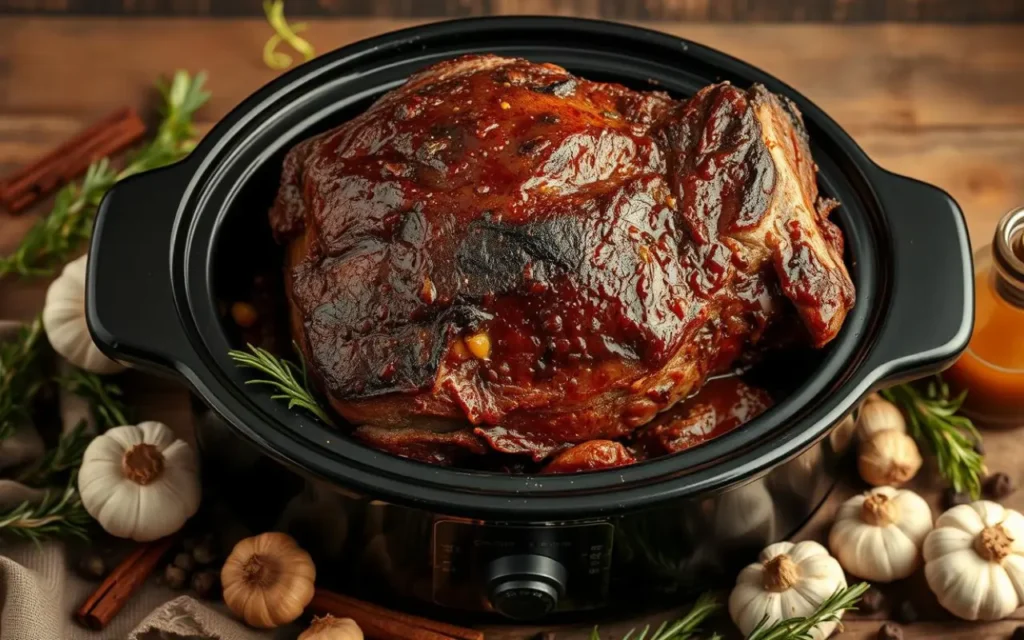
Delicious Side Dishes to Complement Your Roast
Complementing your easy slow-cooker roast with the right sides can turn a simple meal into a feast, The key is to balance flavors and textures to create a harmonious dining experience.
Traditional Accompaniments
Classic side dishes have stood the test of time for a reason, They complement the rich flavors of a slow-cooked beef roast without overpowering it, Some timeless options include:
- Mashed potatoes, a comforting favorite that pairs well with the tender beef.
- Roasted vegetables, such as carrots and Brussels sprouts, which add a nice contrast in texture.
- Freshly baked bread, perfect for sopping up the savory juices.
As Julia Child once said, “The only time to eat diet food is while you’re waiting for the steak to cook” This quote encapsulates the indulgent nature of a well-cooked roast beef dinner.
Creative Alternatives to Standard Sides
For those looking to innovate, there are numerous creative side dishes that can add a modern twist to your meal, Consider:
- Saffron-infused quinoa salad, offering a sophisticated and aromatic flavor profile.
- Grilled asparagus with lemon butter, providing a bright and refreshing contrast.
- Roasted sweet potato wedges with a spicy kick, adding a delightful crunch.
One-Pot Meal Options
One-pot meals are a convenient and flavorful way to enjoy your roast beef, By cooking your sides alongside the roast, you can create a cohesive and satisfying meal, Some ideas include:
- Cooking root vegetables like parsnips and turnips directly in the slow cooker with the roast.
- Adding potatoes and onions to the slow cooker for a hearty, comforting meal.
- Incorporating grains like barley or rice into the cooking liquid for added depth of flavor.
By exploring these options, you can find the perfect accompaniments to make your delicious beef roast the centerpiece of a memorable meal.
Troubleshooting Common Slow Cooking Problems
Slow cooking a tender beef roast can sometimes be tricky, but knowing how to troubleshoot common problems can save your meal, Whether you’re using a slow cooker or a Dutch oven, issues like dryness, toughness, or lack of flavor can arise, but there are effective solutions.
Fixing Dry or Tough Results
Dry or tough results are often due to overcooking or using the wrong cut of meat, To avoid this, ensure you’re using a cut suitable for slow cooking, such as chuck or brisket, which have enough marbling to stay tender.
Key Tips:
- Use a meat thermometer to check for doneness.
- Keep the roast covered during cooking to retain moisture.
- Avoid lifting the lid too often, as this can cause heat loss.
Adjusting Flavors and Seasoning
If your slow-cooked roast beef lacks flavor, it might be due to insufficient seasoning or inadequate liquid, Adjusting the seasoning and ensuring there’s enough cooking liquid can make a significant difference.
“The key to a flavorful roast is in the balance of spices and the quality of the cooking liquid”
Consider adding aromatics like onions, carrots, and celery to enhance the flavor, You can also experiment with different spice blends or marinades before cooking.
| Flavor Component | Suggestions |
| Herbs | Rosemary, thyme, parsley |
| Spices | Garlic powder, paprika, black pepper |
| Liquids | Beef broth, red wine, stock |
Rescuing an Overcooked Roast
If your roast is overcooked, there are still ways to rescue it, Shredding the meat and mixing it with a flavorful sauce can make it more palatable.
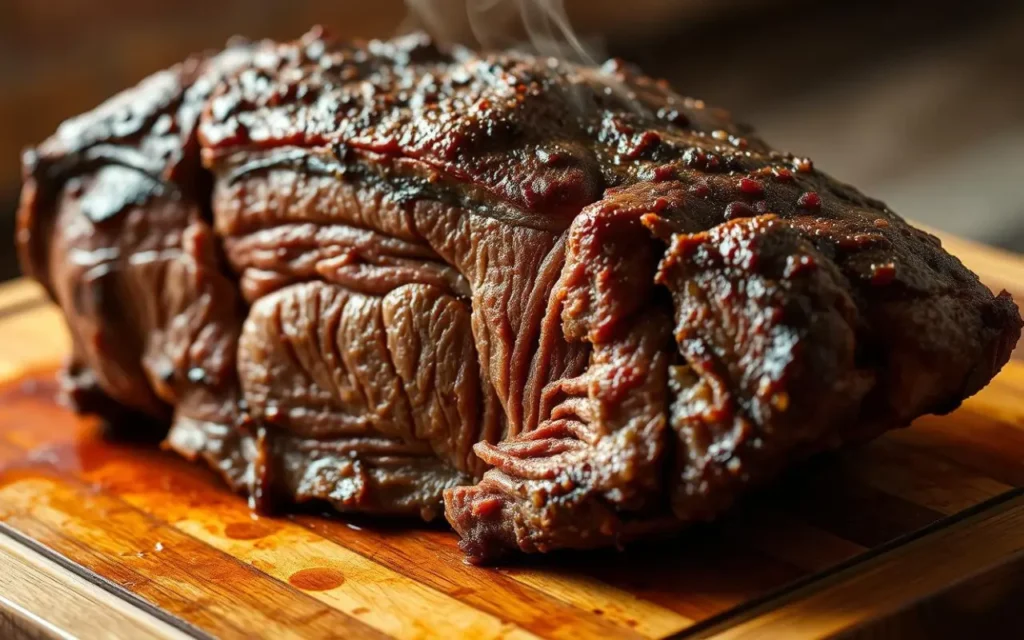
Alternatively, slicing the roast thinly against the grain can make it more tender and easier to eat, Serving it with a rich gravy or sauce can also help mask any dryness.
Conclusion
Now that you’ve explored the world of slow-cooked beef roast, it’s time to put your newfound knowledge into practice, The ultimate beef roast recipe is not just about following a set of instructions, but about understanding the techniques that make a truly exceptional dish.
By choosing the right cut of beef, preparing it with care, and cooking it to perfection, you can create a slow-cooked beef roast recipe that’s sure to impress, Whether you’re a seasoned chef or a beginner in the kitchen, the versatility of slow-cooked beef roast allows you to experiment with a variety of flavors and ingredients.
As you’ve learned, the key to a tender and flavorful roast lies in the slow cooking process, By applying the tips and techniques outlined in this article, you’ll be well on your way to creating mouthwatering slow-cooked beef roasts that will become a staple in your culinary repertoire.
FAQ
What is the best cut of beef for a slow-cooked beef roast?
Chuck roast, brisket, and round roast are popular choices for slow-cooked beef roast due to their flavor and texture when cooked low and slow.
Why is marbling important in a slow-cooked beef roast?
Marbling refers to the intramuscular fat that is dispersed throughout the meat, which helps to keep the roast tender and juicy during the slow cooking process.
Can I use a Dutch oven instead of a slow cooker for slow-cooked beef roast?
Yes, you can use a Dutch oven to cook a slow-cooked beef roast, Dutch ovens are great for slow cooking as they distribute heat evenly and can be used on the stovetop or in the oven.
How do I prevent my slow-cooked beef roast from becoming dry or tough?
To prevent dry or tough results, make sure to cook the roast at a low temperature for a long duration, and use a meat thermometer to ensure the perfect doneness.
What are some common flavor variations I can try with my slow-cooked beef roast?
You can experiment with different herb and spice combinations, international flavors, and wine or other liquid additions to enhance the taste of your slow-cooked beef roast.
How do I know when my slow-cooked beef roast is perfectly done?
You can check the doneness of your roast by using a meat thermometer, or by checking the tenderness of the meat with a fork. The roast is done when it reaches your desired level of tenderness.
Can I make a one-pot meal with my slow-cooked beef roast?
Yes, you can make a one-pot meal by adding vegetables and other ingredients to the slow cooker or Dutch oven with the roast.
How can I rescue an overcooked slow-cooked beef roast?
If your roast is overcooked, you can try shredding it and serving it with a sauce or gravy to mask the dryness, or by using it in a different recipe such as beef sandwiches or beef stew.
What are some traditional side dishes that go well with slow-cooked beef roast?
Traditional side dishes that complement slow-cooked beef roast include mashed potatoes, roasted vegetables, and gravy.
Can I use a slow cooker to make a tender beef roast?
Yes, a slow cooker is a great way to make a tender beef roast, The low heat and long cooking time help to break down the connective tissues in the meat, resulting in a tender and flavorful roast.

